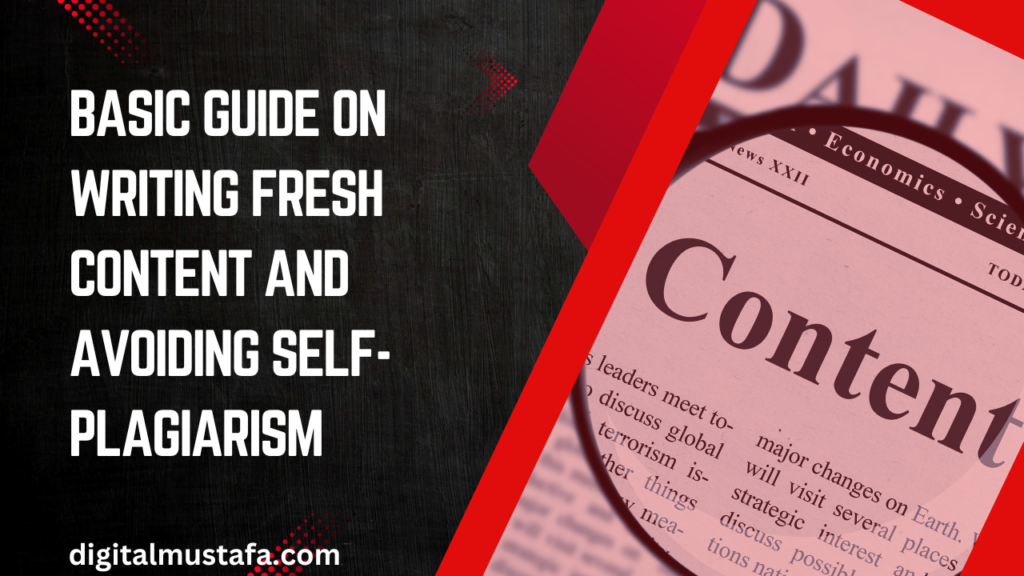If you write a blog post, but no one reads it. How bad it would be!
Nowadays, anyone can craft a blog post. But not everyone can create a blog post that people love to read and share.
If you want people to read and share your blog post, you need to write original and authoritative content.
What does original content mean?
It simply means that you should write fresh content for your blog. Sometimes, many content writers end up with self-plagiarism. So you need to tackle this problem if you really want to drive more conversions and generate more leads for your business.
With that in mind, we have created this article. Here you will learn how to avoid self-plagiarism and write fresh content for your blog post.
Let’s jump right into it!
- Also Read: Plagiarism in SEO
What is self-plagiarism?
Self-plagiarism is the act of using the text you had written and published before and presenting it as an original piece.
It is an unethical and unprofessional practice to republish content without acknowledging your work.
Clarifications on self-plagiarism
Self-plagiarism means you cannot pick content from one blog post and copy-paste it into a new post and say I am fulfilling the writing requirements.
But this does not mean you cannot use the information from your first blog. Not at all!
You can use the previously written information in your blog.
Do you need to come up with new sources?
Absolutely not!
Basically, it means that you can use the information from your first blog in the new one.
The only thing you need to do is reword the content and cite the same source.
Next time you are writing a blog post, how do you make sure that you have not self-plagiarized your work?
Continue reading!
Steps to avoid self-plagiarism & write a top-quality blog post
1. Know who you are speaking to
Now is the time to decide who your target audience is. What do they really want to read?
This is important to keep in mind while writing a blog post since you need to know what your audience wants to read, not what you think they will like.
Determine their key interests and pain points. Then select a topic that addresses their challenges.
2. Conduct research
If you are writing on a topic that you have already covered, you need to conduct research. Even if you are well familiar with the topic, you need to do research again.
You are exposed to new information that may not have been previously available to you.
Starting from the beginning allows you to prevent self-plagiarism while simultaneously including more sources than you would have otherwise used, raising your work’s caliber.
3. Create a compelling headline
There is a very good possibility that no one will read or share your blog post if it does not have a catchy headline.
Humans evaluate both a book and a blog article based on their titles.
Accordingly, the success of your blog post depends on its title.
4. Write short paragraphs & include subheadings
For blog posts, formatting is crucial. Reading a blog article that is just one long paragraph is the worst.
We always advise breaking up your article using subheadings because most readers scan the text before deciding to read it.
Making it easier on the user’s eyes will make it easier for them to read your blog content.
Write shorter paragraphs to help your readers navigate your text.
To assist your reader in absorbing more information in less time, include subheadings in your text.
5. Add Bullet Points
Most readers only scan posts before deciding whether or not to read them in full.
That’s why you must put your best foot forward. In this approach, they can determine right away if your piece is worth reading.
Bullet lists are ideal because they are much easier to skim than text with headings or subheadings.
Here are some tricks you can use to create engaging bullet points:
- The advantages should be written very obvious. Bullet points can be viewed as mini-headlines.
- Make sure your bullets are evenly spaced. Each one is only one or two lines long.
- Do not overcrowd the bullet points. Don’t use bullet points instead of paragraphs.
- Always keep in mind that bullet points are not complete thoughts. They are identical to newspaper headlines in every way.
You can keep your readers interested and engaged by breaking up your content into easily digestible bullet points.
6. Cite previous work where necessary
When it is absolutely important to do so, you can cite any work you have previously completed.
Similar to plagiarism, you are not guilty of it if you credit the original author and the published work. You can include the previously written information in your blog post by paraphrasing it. One foolproof approach to paraphrasing content efficiently is by using an online paraphrasing tool.
A paraphrasing tool is based on Artificial Intelligence that lets you create a different version of the old text. The rephrasing tool changes the sentence structure of the text and replaces words with good synonyms.
In addition, it also trims the long and complicated sentences and makes them short and sweet. In this way, your content will become easy to read and scan.
7. Add a strong call-to-action
We have saved the greatest advice for last: the final key to producing a blog post that converts is a powerful call to action.
Make it very clear to your readers what you want them to do, whether that’s commenting, sharing, following you on social media, or buying a product.
An effective call to action will be noticeable and distinct.
Your blog post’s call to action should always encourage visitors to share the post’s content if they enjoyed reading it.
Conclusion
We have comprehensively discussed how to avoid self-plagiarism and write fresh content for your blog post.
We hope you enjoy this article. So what are you waiting for?
Give the aforementioned tips and say goodbye to self-plagiarism.
Best of luck!



